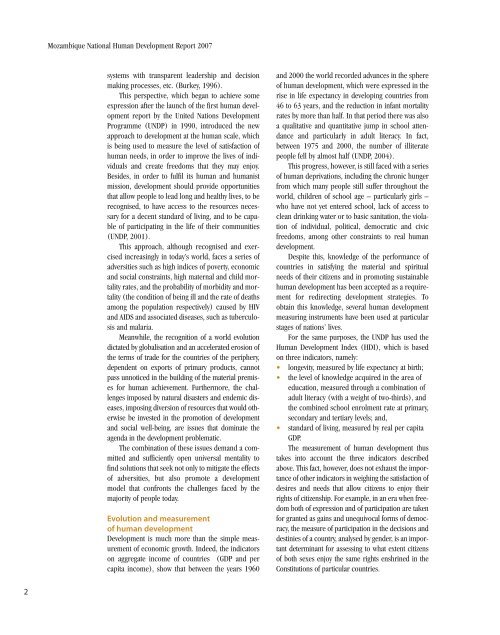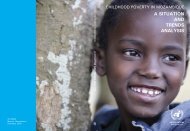English language version - Human Development Reports - United ...
English language version - Human Development Reports - United ...
English language version - Human Development Reports - United ...
- No tags were found...
You also want an ePaper? Increase the reach of your titles
YUMPU automatically turns print PDFs into web optimized ePapers that Google loves.
Mozambique National <strong>Human</strong> <strong>Development</strong> Report 2007systems with transparent leadership and decisionmaking processes, etc. (Burkey, 1996).This perspective, which began to achieve someexpression after the launch of the first human developmentreport by the <strong>United</strong> Nations <strong>Development</strong>Programme (UNDP) in 1990, introduced the newapproach to development at the human scale, whichis being used to measure the level of satisfaction ofhuman needs, in order to improve the lives of individualsand create freedoms that they may enjoy.Besides, in order to fulfil its human and humanistmission, development should provide opportunitiesthat allow people to lead long and healthy lives, to berecognised, to have access to the resources necessaryfor a decent standard of living, and to be capableof participating in the life of their communities(UNDP, 2001).This approach, although recognised and exercisedincreasingly in today’s world, faces a series ofadversities such as high indices of poverty, economicand social constraints, high maternal and child mortalityrates, and the probability of morbidity and mortality(the condition of being ill and the rate of deathsamong the population respectively) caused by HIVand AIDS and associated diseases, such as tuberculosisand malaria.Meanwhile, the recognition of a world evolutiondictated by globalisation and an accelerated erosion ofthe terms of trade for the countries of the periphery,dependent on exports of primary products, cannotpass unnoticed in the building of the material premisesfor human achievement. Furthermore, the challengesimposed by natural disasters and endemic diseases,imposing di<strong>version</strong> of resources that would otherwisebe invested in the promotion of developmentand social well-being, are issues that dominate theagenda in the development problematic.The combination of these issues demand a committedand sufficiently open universal mentality tofind solutions that seek not only to mitigate the effectsof adversities, but also promote a developmentmodel that confronts the challenges faced by themajority of people today.Evolution and measurementof human development<strong>Development</strong> is much more than the simple measurementof economic growth. Indeed, the indicatorson aggregate income of countries (GDP and percapita income), show that between the years 1960and 2000 the world recorded advances in the sphereof human development, which were expressed in therise in life expectancy in developing countries from46 to 63 years, and the reduction in infant mortalityrates by more than half. In that period there was alsoa qualitative and quantitative jump in school attendanceand particularly in adult literacy. In fact,between 1975 and 2000, the number of illiteratepeople fell by almost half (UNDP, 2004).This progress, however, is still faced with a seriesof human deprivations, including the chronic hungerfrom which many people still suffer throughout theworld, children of school age – particularly girls –who have not yet entered school, lack of access toclean drinking water or to basic sanitation, the violationof individual, political, democratic and civicfreedoms, among other constraints to real humandevelopment.Despite this, knowledge of the performance ofcountries in satisfying the material and spiritualneeds of their citizens and in promoting sustainablehuman development has been accepted as a requirementfor redirecting development strategies. Toobtain this knowledge, several human developmentmeasuring instruments have been used at particularstages of nations’ lives.For the same purposes, the UNDP has used the<strong>Human</strong> <strong>Development</strong> Index (HDI), which is basedon three indicators, namely:• longevity, measured by life expectancy at birth;• the level of knowledge acquired in the area ofeducation, measured through a combination ofadult literacy (with a weight of two-thirds), andthe combined school enrolment rate at primary,secondary and tertiary levels; and,• standard of living, measured by real per capitaGDP.The measurement of human development thustakes into account the three indicators describedabove. This fact, however, does not exhaust the importanceof other indicators in weighing the satisfaction ofdesires and needs that allow citizens to enjoy theirrights of citizenship. For example, in an era when freedomboth of expression and of participation are takenfor granted as gains and unequivocal forms of democracy,the measure of participation in the decisions anddestinies of a country, analysed by gender, is an importantdeterminant for assessing to what extent citizensof both sexes enjoy the same rights enshrined in theConstitutions of particular countries.2
















